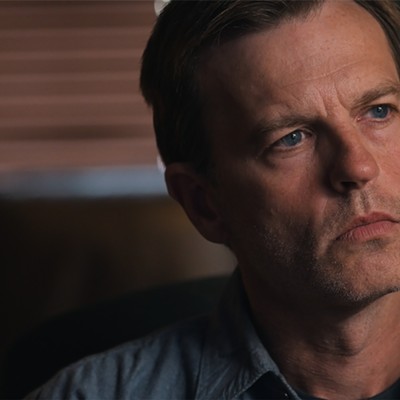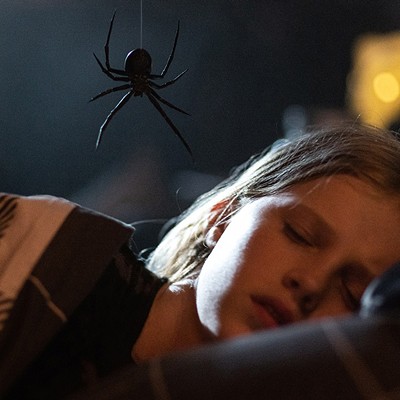The Spokane International Film Festival suddenly feels very grown up. It was touch and go there for a few years. Even though the selections were usually very strong, there were times not even the Festival board would know what movie was going to be screened until the night before, to say nothing of getting screeners to the press for review. Those problems seem to have been ironed out in the lead up to the 8th annual festival (Feb 3-9 at the Met). The lineup was locked down months ago, screeners were sent out, filmmakers were scheduled to give talks. All those things that needed to happen to elevate SpIFF from a kitschy shoestring fest to a serious international festival have happened, and they did it without sacrificing the local element.
Three local films and NxNW's popular 48 Hour Film Festival made the cut. Two of them, What's in the Barn and The Mantis Parable, though shorts, offer some of the best and most enduring moments of any films at the festival. They are not to be missed. -- Luke Baumgarten
All Shows at the Met. $9 per ticket, $40 Five Film Pass, $92 13 film, full festival pass. Call 325-SEAT, or purchase at the Met box office.
What's in the Barn? — USA : 30 minutes : Feb. 4, 2:30 pm & r & Out of nowhere, and at the very last minute, four local filmmakers have created the most original (certainly the creepiest, artsiest), most exciting film you'll see at SpIFF this year. Shot on a shoestring and edited over a year and a half, What's in the Barn? does more with lighting, sound, mood and an 8-year-old actress than most thrillers do with million dollar budgets, and more than most avant-garde directors do with their drug problems and NYU film degrees. I caught up with the filmmakers, Derrick King, Mike Corrigan (former Inlander staffer), Gary McLeod and Travis Hiibner.
How long have you been working together?
KING: This is our first collaboration with Mike. I've done stuff with Travis and Gary. Mike acted in our last film, Stoic.
CORRIGAN: Seeing how they worked, while I was acting, it looked like they had it together, and I really wanted to work with them on the other side of the camera. So toward the end of Stoic, I came to them with an idea ... it was basically just a title: What's in the Barn?
Where'd the title come from?
CORRIGAN: We went out to a farm that summer to a party where my friend was house-sitting. And at night it was just really spooky, so the idea came from that. Looking at that barn at night. So I just came to them and said, 'Hey, I've got this crazy idea for a title ...'
So where'd the story come from?
McCLEOD: Then we went out to the location [the same barn that inspired the film] over Fourth of July weekend, and we just started looking around. We found the wagon out there. We found the little table and chairs out there and the hole in the barn, and all the little things that we found kinda crafted the story. We put in a little girl and it kinda wrote itself. We came back and went out separate ways for a few days, then got back together and wrote most of the story in just one day.
What are some of the things you were inspired by when filming?
CORRIGAN: Each of our actors had a great look.
HIIBNER: They were a big creative part of the film. We told them the basics of the scene, and they went and designed their whole role.
CORRIGAN: We're not really used to giving direction to actors ...
HIIBNER: [laughs] and it worked out OK. We were telling [lead actress] Kate [Dinnison], 'Just be a little girl, Kate.'
I wanted to talk about Kate Dinnison -- she's amazing.
McLEOD: She was great at improvising. She would bring all these creative little things to us. I think she was turning 8 at the time.
KING: She was by far the smartest person in the production.
McLEOD: And she was so patient. This 8-year-old's more mature than most people I know.
CORRIGAN: Pretty much everything you see her doing, she improvised. It was really natural.
HIIBNER: Plus we told her if she blew a scene she'd be fired. We pounded that into her every chance we got.
Were you surprised to be selected?
KING: I was. I was really surprised.
McLEOD: Just the length of it. For a short, it's a really long short.
CORRIGAN: Plus it's kind of a hybrid. We're obviously very pleased.
The Mantis Parable USA : 8 min. : Feb. 3, 5:30 pm, and Feb. 9, 8:30 pm & r & Josh Staub has been the art and visual design director at Cyan Worlds in Spokane since 1997. Now, with the success of his animated short, which has won seven awards at six film festivals (including best animated short at the Hollywood Film Festival), he's bringing his work to SpIFF.
Where'd the story idea come from?
It's a little bit hard to know where an idea comes from, but I knew that I wanted to tell a story that had a simple message, and I also liked the idea of a parable. So nothing that was overtly there or heavy-handed with the message. Something simple that a lot of different people would appreciate.
Was simplicity what made you decide to forgo dialogue?
Yeah, I think that's part of it. Some of it could have just been I knew I was going to be doing the whole film myself, and I also knew it was going to be CG. And I wanted something that was going to be more realistic than the Pixar, really cartoony-looking stuff. So all of those things pointed to doing a pantomime.
But they certainly recognize things in their environment that you wouldn't expect a caterpillar to recognize and understand.
Right. Yeah. It's kinda different, I think. I spoke with some kids about it this morning. They asked why didn't they talk. I think we're so tuned in to A Bug's Life, where the ants walk around on two legs and have two arms, and I kinda wanted to do something in between. A lot of my CG work is on the really realistic end. So it actually was a gravitation toward something more cartoony. At the same time, I wanted them to be more believable.
As I was experimenting with different looks, I caught a couple preying mantises near my house and brought them home and let them run around on our breakfast room table. It's amazing, you know, with insects or with dogs or with anything -- pets -- you look at them, and they have personality. Some of it, I'm sure, is that our minds are adding it. But it's amazing how, with just a few gestures, you can see some character. So I kind of took that to the extreme. I took some artistic license and tried to have them emote a little more than they would.
Did you imagine in your wildest dreams the kinds of accolades you've gotten?
I didn't. I mean, I wanted to shoot for the best quality I could. I'm a big fan of short films and kind of knew what was out there as far as animated short films go, but I didn't expect it to be quite this big. When you're working on something, especially when it's completely on your own, it's hard to see how other people are going to receive it. You're sort of in a vacuum. It pretty much took off right out of the gate and it hasn't stopped. It's been amazing.
It must be crazy seeing a press release [from the Hollywood Film Festival] with a lot of talk about Mantis Parable then like, lower down, almost as an afterthought, you've got names like Quentin Tarantino....
It's totally crazy. The Hollywood Film Festival, as far as the glitz angle, was just over the top. Being at the Beverly Hilton with Tarantino and George Lucas -- it was totally surreal.
Are you going to attend your screenings at SpIFF?
My schedule has been so crazy. I'm actually going to be in town for my screening, but then I fly to Santa Barbara for their film festival. And then it's in San Diego the next week. Then I'm coming back for the closing night. So I'm going to miss the bulk of the festival, but [I'll be there] at least for the nights it's screening.
The Porcelain Doll Hungary : 75 min. : Feb. 4, 2:30 pm & r & Incorruptible bodies, disappearing Swabian Couples, wound healing, dead resurrecting, The Porcelain Doll is a series of vignettes absolutely full of folk surrealist weirdness.
Based on the stories of Ervin Lazar, the film oozes the spooky uncertainty of a fairy tale and utilizes the inventive off-kilter direction of Peter Gardos to make you question and contemplate everything you're seeing. You've got a super athletic kid who's gunned down by occupying Soviets while running a race, yet finishes in first place, much to the comrades' consternation. You've got a party official who promises to resurrect the dead. You've got an old couple who, fearing relocation, disappear into thin air. Are these stories meant to be taken at face value? Are they meant as metaphors? In American cinema, the answer would be simple, but in places like Lazar's Hungary (and in the Colombia of Gabriel Garcia Marquez), you can't assume that. This is a place where, for thousands of years, people have lived side by side with their beliefs and their demons, where the spirit world is inseparable from the physical.
Shot much like a book might be written, The Porcelain Doll is contemplative but engrossing. Both in its pacing and sparse dialogue, the film forgoes most common story telling techniques to focus the audience's attention on things not said. The deep cut lines of a farmer's face. The tears of a wife who watches her husband's body decompose in front of her.
Consistently engrossing, the film ends with shots of contemporary Hungarians, the descendents, presumably, of the people in the film (these new characters are played by the same actors). The Hungarian way of life persists despite their circumstances, Gardos exclaims in these final moments. Though a secondary point is made as well: that the country's chief emotion and export has, with the promise of the Euro, transitioned from weary, austere melancholy and agrarian labor to euro-trash posturing and throbbing house music. Long live the EU.
Go For Zucker! Germany : 90 min. : Feb. 4, 8:30 pm & r & When Zucker (Henry H & uuml;bchen), a lecherous, atheist pool shark, failed business owner and small time con-man must reunite with his disapproving and ultra-devout brother over of the passing of their mother -- a woman Zucker hadn't seen since he defected to Soviet East Berlin -- uniquely German hilarity ensues. First, given the devoutness of the old bird and his placement in central Berlin, Zucker must not only house his brother, sister-in-law, nephew and neice for a week, but, in accordance with Jewish law, has to go ultra kosher as well. This sends his well-meaning but helplessly goy wife Marlene (Hannelore Elsner) into an "I don't know the first thing about Judaism" panic while Zucker continually sneaks around, trying to wrangle entrance into a pool tournament that will hopefully yield enough cash to save his business.
This film has been compared to Good Bye Lenin, but that's a somewhat tenuous connection. The two are only really similar in their meditations on transitioning from communism to capitalism. This is more about family and religion than party loyalties and the shock of rewriting oneself in a new governmental paradigm.
German filmmakers finally seem to be ready to explore their reunification. It's an incredibly fertile subject matter and setting for film. Go For Zucker! certainly explores a new angle, religion (notably Judaism). It would've been nice, though, to see the themes of faith and alienation more fully fleshed out and the comedy darker.
Mongolian Ping Pong China : 101 min. : Feb. 3, 5:30 pm & r & The instant it comes floating down a river, you know it's a ping pong ball; I know it's a ping pong ball. So why watch 101 minutes of some kids who are baffled by the smooth round thing?
Because it's beautiful -- and it's funny.
Bilike and his friends Dawa and Erguotou are 7-year-old boys -- fearless and curious -- who seemingly have free reign of the steppes. This vast grassland, with horse herds and sheep and very few humans, is achingly beautiful as the backdrop for this heartwarming (and I mean that only in the best way) story.
Told at first they have found a glowing pearl, treasure of the river spirits, the boys furiously puzzle out the nature of this thing found in the river and finally deduce if ping pong is the national sport, then they are indeed holding a treasure -- the national ball.
"The nation must be very worried," they say, and set off by horseback and scooter to return the treasure to Beijing.
The film has the pacing of haiku: The camera taking us from place to place, offering sparse events that are almost never explained.
Plus: the opening and closing scenes feature throat singing! (Kevin Taylor)
Weird Sex and Snowshoes Canada : 60 min. : Feb. 6, at 8:30 pm & r & "I have to get sex in here, and I have to get snow in here, because those are sort of the two defining elements" of Canadian cinema, says Katherine Monk. She's the author of the book on which this hour-long documentary, subtitled A Trek Through the Canadian Cinematic Psyche, is based.
For James Spader in David Cronenberg's Crash (1996), for example, the sex is better if it happens right after an auto accident. Preferably one he was involved in and which lands him in the snow.
Freaky, sure, but our neighbors to the north aren't uniformly eccentric -- or even amused. One director, for example, talks about Cronenberg's Dead Ringers as a reaction to Eisenhower -- "not just to the complacency, but also to expose the deep unhappiness in our society."
Jill Sharpe's 2004 documentary takes on an impossible task: generalizing about films both quirky and sad that range across a continent.
Consider the following, all of which are excerpted (like Cronenberg's work) in this film about Canadian film: Atom Egoyan's Ararat (2002), about a Canadian's view of the Armenian genocide; Egoyan's The Sweet Hereafter (1997), about a school bus crash in a small town; Bruce Beresford's Black Robe (1991), about missionary work in 17th-century Quebec; Francois Girard's The Red Violin (1998), tracing the history of a fiddle that ends up back in Montreal; Denys Arcand's Jesus of Montreal (1989), in which actors' lives start reflecting the Passion Play they're putting on; Arcand's The Barbarian Invasions (2003), about family and friends visiting a dying man; and Atanarjuat: The Fast Runner (2001) by Zacharias Kunuk, about an Inuit legend. Canada's landscape is so enormous and so intimidating, says Kunuk, that "you have to have enough sense of self that you can make it out in the wilderness."
Canadians feel like they're "always on the outside," of their own country, says director Patricia Rozema. "The French Canadians don't feel part of it. The B.C.'ers don't feel like part of it." Monk thinks Canadian movies have a shared outlook, all right: She calls it "unified outsiderism."
Some of that out-of-bounds mentality arrives in the title's promise: a weird sex segment featuring vibrators, strange gynecological instruments, necrophilia and a man with a woman's toes up his nose.
Maybe filmmaker Don McKellar summarizes it best when he quotes a film festival director saying that, "As long as there is Canadian film, there will be independent film in North America."
Behemoth studios in the States aren't maintaining our cinematic integrity, the Canadians are. (Michael Bowen)
The Outdoorsmen: Blood, Sweat and Beers USA : 91 min. : Feb. 6, 5:30 pm & r & Did you ever think that the goofy stuff you do with your old high school buddies would make a great movie? After a beer or 10, you can really get worked up about it. In The Outdoorsmen: Blood, Sweat and Beers, filmmaker Scott Allen Perry decided the annual summer pilgrimage of this bunch of friends was perfect for big-screen documentary treatment.
In kind of a cross between Animal House and Survivor, these Cascade (Everett, Wash.) High School grads take to the hills of western Washington every summer to stay in touch with their inner adolescent by trying to outdo -- and outdrink -- each other. They've come up with a competition that is totally inane and therefore makes perfect sense. Teams of two must tough out 15 different events, and the teammates who win the most points over the course of one beer-soaked day are crowned the Outdoorsmen for the ensuing 364 days. Jeff Probst's bunch of babies never had to haul a 75-pound log through a rocky creek bed with a 0.12 blood-alcohol level.
It goes without saying, but groveling on the ground while blindfolded for a can of beer has never been a staple of the film festival circuit. Still, The Outdoorsmen has been screened by the Tribeca Film Festival and the Austin Film Festival, perhaps for the psychological drama that lurks just under the veneer of testosterone. What is the source of this primitive male need to escape to the woods together? How do you maintain those ties that were forged with bottle rockets and stolen cigarettes back at age 14? You find a common language -- of pointless struggle, of gratuitous cursing, of fermented hops and barley. As a way to cope with the banality of modern life, it ain't bad.
Now if they'd just pass out cold cans of Budweiser you can crush into your gullet every time somebody pukes on screen, they might just have an underground cult classic on their hands. (Ted S. McGregor Jr.)
Post-screening talks will be held after each session, often with the filmmakers in attendance.























